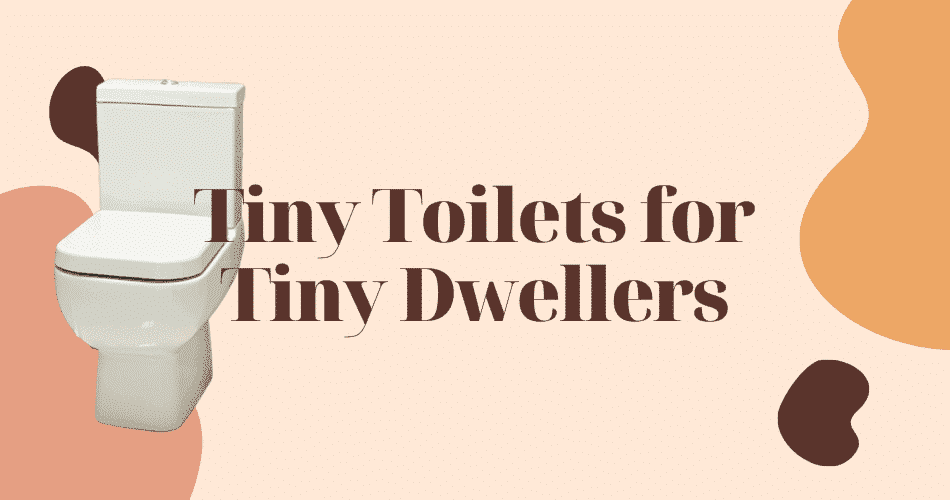The minute you tell someone you live in a tiny house, you know the question is coming—you can see it in their eyes.
How do you go to the bathroom?
For tiny dwellers, picking a bathroom becomes a much bigger issue than for those living in a traditional home.
Without access to regular sewage or septic systems, alternative toilet options have to be considered.
Thankfully, there are lots of good alternatives available now.
We’ve put together a comprehensive guide comparing 5 different types of tiny house toilets to help you figure out the best one for your needs.
**Note** This article is intended to teach you about tiny house toilets. If you are looking to purchase a tiny house toilet, please check out the following article: The 4 Best Composting Toilets of 2025 (Reviews & Buying Guide)
Composting Toilets For Tiny Houses
Composting toilets are probably the most common type of alternative toilet system for tiny houses.
I have personally owned a high-quality composting toilet, called Nature’s Head, for years in my tiny home, and highly recommend it.
They work using the natural process of decomposition to break down waste and turn it into usable compost.
For a complete review on our favorite composting toilets, you can find it here.
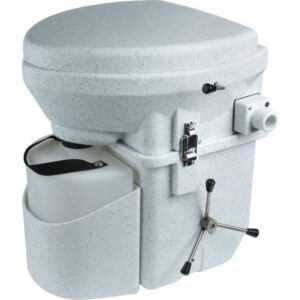
How Do Composting Toilets Work?
Composting toilets are one of the oldest waste management systems in the world.
You’re basically just letting natural bacteria break down waste in a controlled manner.
Composting toilets only require a few things to work effectively:
- Ventilation
- Urine diverter
- Bulking materials like sawdust
The ventilation helps remove additional moisture and allows the aerobic processes that begin to break down the waste.
Since urine has a very high water content ,it’s always a good idea to separate it from solid waste when possible.
Bulking materials, such as sawdust or coconut husks, help to create air gaps that speed up the process of decomposition. They also encourage the growth of beneficial bacteria and help decrease the amount of potentially harmful bacteria.
What Are The Different Types Of Composting Toilets?
There are two broad categories of composting toilets. These are slow composting units and commercial active composting ones.
Slow Composting or Homemade Composting Toilets
Slow composting toilets are about as basic as it gets. You can start off with something as simple as a 5 gallon bucket with a toilet set rim.
These generally don’t have ventilation or any other system to aid in the breakdown of waste.
If you’ve ever hiked in primitive conditions, you’ve no doubt encountered vault toilets.
Slow composting tiny house toilets work on the same principles, just on a smaller scale.
The downside to this is that you have to deal with the waste. For tiny house systems, that means bagging waste and moving it to a compost pile.
Most people do this by putting an extra thick contractor trash bag in their toilet.
Slow composting toilets are also highly likely to produce a negative odor if not religiously sealed and cleaned.
If you plan to have a lot of guests over, they may not enjoy using them. However, if you’re looking for the cheapest, most basic toilet option for your tiny house, this is it.
Active Composting Toilet
Active composting tiny house toilets are more advanced versions of slow composting ones. They’re fully contained units with a traditional toilet seat and a sealed canister to act as a composting chamber.
Most have full ventilation systems, a urine diverter, and are designed to fully break down the waste inside the toilet system.
The only downside to these systems is their high price. Any quality active composting toilet will run you well over $1,000.
Pros of composting toilets
- Can be made very inexpensively yourself
- Wide range of commercial models and types available
- Completely portable and easy to maintain
- Can produce rich compost if local regulations allow
Cons of composting toilets
- Homemade versions often produce noticeable smells
- Requires regular emptying
- Commercial units can be very expensive
- Won’t work in low temperature or abnormally high or low humidity levels
- A big change from traditional toilets
Macerating Toilets
Macerating toilets are very similar to traditional flush toilets with the addition of a unit to grind up waste. Thus, instead of solid waste and urine, it leaves you with a flurry of liquified slurry that is easier to pump out and store.
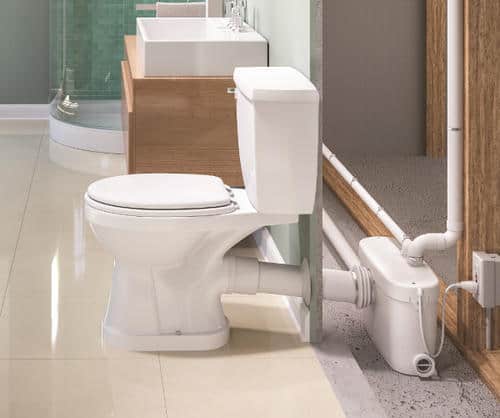
How Do Macerating Toilets Work?
Most macerating toilets were designed for use with low water flow systems or when the toilet is sited below the main drain line.
By macerating the waste, it’s possible to use nothing but water pressure to move it over greater distances.
Now for the bad news…
Macerating toilets require both full plumbing and an electrical hook up.
This is great if you’re planning to build your tiny home on a foundation, but not so great for a THOW
They’re much easier on older or smaller scale septic systems.
So while not perfect for THOWS, a macerating toilet can be an excellent choice for someone looking to live off grid.
Pros of macerating toilets
- Require smaller pipes and less plumbing
- Great for reducing the impact of more people on septic systems
- Feels just like a traditional toilet
Cons of macerating toilets
- Require both water and power hookups
- Won’t work for THOW
- Expensive
- Generally need to be professionally installed
Incinerating Toilets
A favorite of remote cabins and seagoing folk for decades, incinerating toilets provide effective and instant disposal of waste.
They work by burning waste immediately after you finish your business.
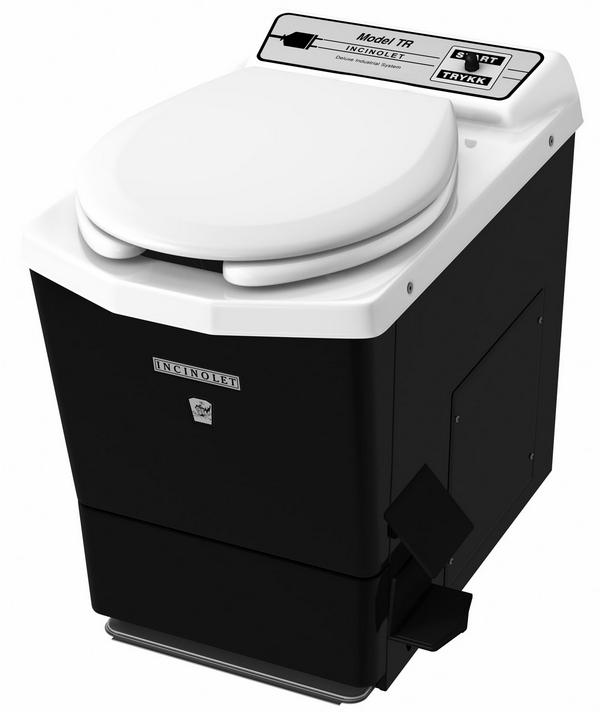
How Do Incinerating Toilets Work?
Incinerating toilets look a lot like a regular toilet at first glance.
Once you open one up, though, you’ll start to see the differences. They’re made from metal and require the use of a piece of paper every time you need to go.
You place the paper into the bowl, do what you have to do, and then seal the lid. Most work using a foot pump or button system that opens a trap door to the incineration chamber.
When you release your foot, anything in the bowl is quickly reduced to sterile ash. This allows you to dispose of it in your household trash without any risks whatsoever.
In the past there was a significant odor that smelled like, well, burning poop. Thankfully, recent advances have almost entirely eliminated this.
And while most manufacturers claim they smell than their composting toilet counterparts, from personal experience I can say burning poop is not odorless.
And while most manufacturers claim they smell less than their composting toilet counterparts, from personal experience I can say burning poop, while close, is not 100% odorless.
<Enter “not shocked” face here>
Because they require no water, these are great for 100% off grid living or in a THOW.
They’re available in both electric and gas-powered units, depending on your power situation.
Expect each ‘flush’ to require about 1-1.5 kWh or around 8-10 cents worth of propane.
The only real downside to incinerating toilets, besides that they require power, is their cost.
You should expect to spend a minimum of $1,500 for a barebones model, and can easily spend over $4,000.
Pros of incinerating toilets
- Easy to use
- Newer models mostly odorless
- Sterile ash can be disposed of anywhere
- Requires no water and potentially very limited power
- Work in any climate or weather conditions
Cons of incinerating toilets
- Older models produce a noticeable odor
- Can be intimidating to use at first
- Expensive
Dry Flush and Cassette (RV Style) Toilets
Dry flush and cassette toilets both work on the principle of containing waste for easy dumping.
Dry flush toilets actually wrap the waste up individually, while cassette toilets contain them in a small tank.
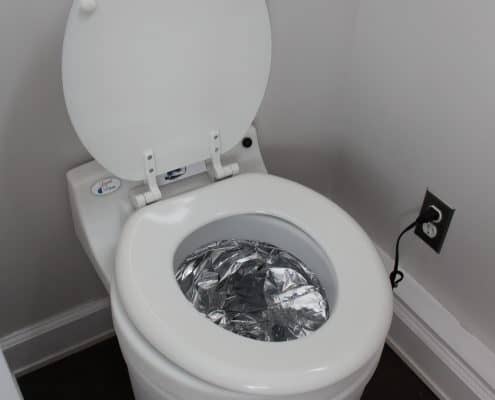
How Do Dry Flush Toilets Work?
Dry flush toilets are one of the easiest-to-use systems for tiny house toilets. They operate with a standard toilet seat connected to a reel of material used to wrap up waste.
When you press the flush button on your toilet, it moves the material down and twists the bag to wrap up any waste.Once you reach the end of the cartridge of wrapping, you pull the sealed bag out of your toilet and throw it away like you would any other trash.
Dry flush toilets require no water to run and can function off of battery power.
Most manufacturers say you can get several hundred flushes from one charged battery, perfect for off grid living.
Even better, dry flush toilets tend to be fairly inexpensive. You can usually find toilets for right around $500.
The only real downside is that they aren’t as environmentally friendly as composting or similar toilet options.
You’ll have to continue using the disposable wrapping material indefinitely.
Pros of dry flush toilets
- Easy to use and maintain
- Inexpensive
- Odorless
- Waste can be easily disposed of
Cons of dry flush toilets
- Requires constant use of foil and plastic lined wrapping material
- Can’t be used for compost
How Cassette (RV Style) Toilets Work
Cassette toilets are a low cost and sustainable toilet option for tiny dwellers who plan to move around frequently.
They operate the same way camping or RV toilets do.
Instead of a regular sewer hookup, waste is stored in a cassette tank that can be easily removed and emptied as needed.
You can either build a custom system with a grey and black water tank or use a commercially available camping or cabin cassette toilet.
Cassette toilets operate in much the same way a traditional toilet does. They usually have a manual or automatic flush mechanism and a way to deposit waste into the cassette.
You can empty smaller units in a standard toilet or at any RV dumping station.
If you plan to live permanently in one location, they can work if you have regular access to a standard toilet.
Pros of cassette toilets
- Easy to use
- Inexpensive
- Tons of options
- Mostly odorless
- Waste can be disposed of into any toilet or dumping station
Cons of cassette toilets
- Dumping takes some getting used to
Biogas Digester Toilets
Closely related to composting toilets, biogas digester toilets rely on anaerobic digestion performed by bacteria.
Not only do they completely break down human waste, they also produce cooking gas and an organic fertilizer liquid.
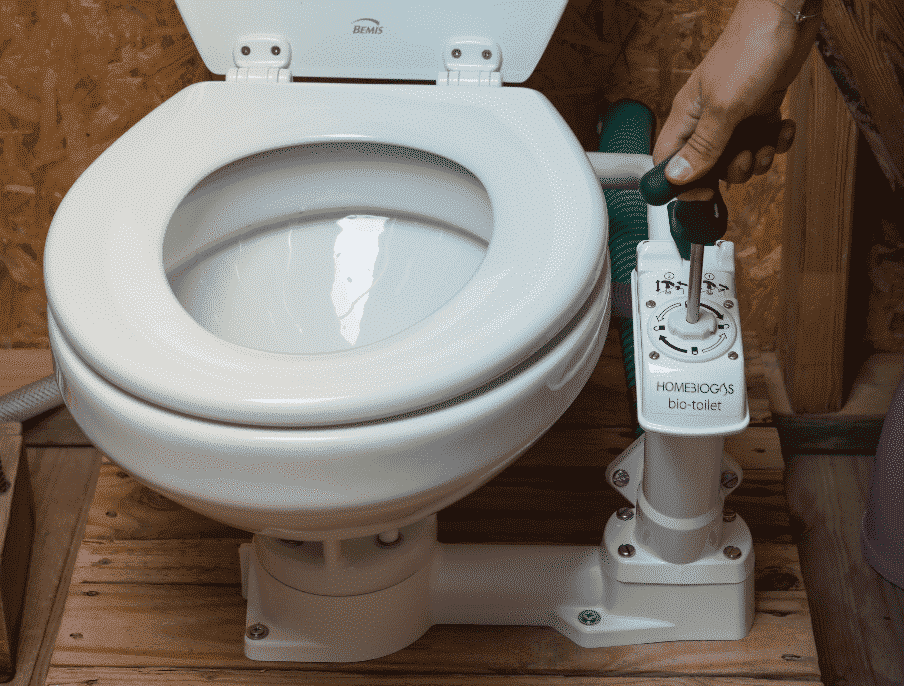
How Do Biogas Digester Toilets Work?
A biogas digester is basically just a system of tanks filled with bacterial colonies. You put food, animal, yard, or human waste in with water and let the bacteria eat them.
They produce methane and carbon dioxide while breaking down all the organic waste safely. Biogas toilets can be as simple as a composting toilet that you empty into a biogas reactor or as sleek as a purpose-built unit.
One company in particular, HomeBiogas, has developed an affordable and easy to use toilet and digester combo. The HomeBiogas 2.0 combines an effective digester system with a hand pump toilet.
The toilet itself is a standard porcelain unit that uses only 1.2 liters of water per flush. Once you’re done using it, you just pressurize the system using a small hand pump.
Pros of biogas digester toilets
- Relatively inexpensive
- Can be combined with a traditional composting toilet
- Fully breaks down waste
- Requires no plumbing or electricity
- Produces usable cooking and heating biogas
- Very similar to using a standard flush toilet
Cons of biogas digester toilets
- Biogas digesters don’t function at low temperatures
- They aren’t as portable as traditional composting systems
Honorable Mention: Flush Toilets
No list on tiny house toilet options would be complete without at least mentioning traditional flush toilets.
We’ll spare you a description of how they work, but suffice it to say they aren’t too ideal for THOWs or many off grid living situations.
If you plan on living in a foundation tiny house within the city, then of course you can still use a traditional toilet.
Flush toilets require a full water hookup and must be permanently connected to either a municipal sewer or septic tank system.
It’s not feasible to disconnect and reconnect a toilet.
If you’re living fully off grid, it can be possible to have a septic system installed, but it’s usually not cost effective.
Pros of flush toilets
- It’s a toilet
- You’ve used one forever
Cons of flush toilets
- Requires full and permanent water hookups
- Can’t be used on any THOW
- Won’t work in freezing conditions with septic or sewer systems
Be Ready for The Question
When people consider going tiny, everyone and their nosy in laws start to ask questions.
Make sure you know the best tiny house toilet options available and the pros and cons of each system.
For most tiny dwellers, composting toilets are going to be the way to go. They’re highly flexible, easy to set up, and require only limited maintenance.
Depending on local laws and how you plan to travel though, something like a cassette toilet may be the better option.
Make sure you spend a little time considering where you intend to use your toilet, how it needs to travel, and how much use it will see.
Once you know these things, you’re ready to pick out the best tiny house toilet for your needs.
Suggested Reading: The Best Tiny House Composting Toilets: Choosing The Right One

